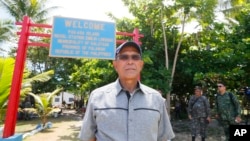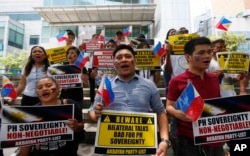The Philippines has found funding for the biggest in a series of infrastructure upgrades planned on the islets it holds in the contested South China Sea, a move that will gently remind other countries, including China, of Manila’s claims.
Money from the Armed Forces of the Philippines’ Modernization Program will next year fund the paving of a 1,300-meter-long gravel and dirt runway on Thitu Island, Defense Secretary Delfin Lorenzana was quoted saying this month. Thitu anchors Manila’s holdings in the Spratly archipelago, which is also disputed by China, Taiwan and Vietnam.
The runway upgrade is expected to lead to repairs of barracks, water systems and other infrastructure on nine Spratly islets controlled by the Philippines per a pledge in April from the country’s president, Rodrigo Duterte. The 15-year Modernization Program hatched in 2012 has a budget of $2.56 million this year.
Manila’s upgrades would serve as a reminder, yet one unlikely to outrage other countries, that it intends to hold on to its nine Spratly features.
Beijing, the most aggressive claimant in those 100-plus islands as well as the broader South China Sea around them, has befriended the Philippines over the past year but only after years of diplomatic hostility that some Filipinos fear could resurface.
“I imagine there’s a feeling that the time has come to consider other options,” said Jonathan Spangler, director, South China Sea Think Tank in Taipei. “I just think it’s more like a hedging thing, like making sure you don’t go all the way in one direction.”
After China parked research vessels over an ocean plateau off the Philippine Pacific coast, Duterte faced public pressure to resist Beijing again. In April he vowed to upgrade the Spratly holdings.
Two months ago, a Chinese vessel apparently planted its national flag on Sandy Cay, which lies in the Philippine-controlled part of the Spratly chain, touching off more concerns among Filipinos. Both countries prize the sea for its fisheries and fossil fuel reserves.
Ambitions for the Spratly Islands
The Philippines can help lock in its Spratly claims by showing human habitation and economic activity, Spangler noted. About 100 civilians, many connected to military activity, live on Thitu Island, the chain’s second largest natural land form at 37 hectares (91 acres). Some in the Philippines advocate opening it to tourism.
Lorenzana visited Thitu in April to “check on the condition of the residents,” according to a defense department statement.
The unpaved runway can only allow military aircraft, mostly for transport, limiting who can access the island, analysts say.
Plans to refurbish infrastructure in the Spratly Islands fits with a “natural order of things” that any country would do to improve defense, said Eduardo Araral, associate professor at the National University of Singapore’s public policy school. The modernization budget must be spent, he added.
“I wouldn’t read too much in this. Clearly it’s defensive in nature,” he said. “It’s a routine part of modernization.”
The Philippine military ranks No. 50 in the world on a list of 133 countries tracked by the research database GlobalFirePower.com.
Mixed Sino-Philippine relations
Tighter relations with China also reduce the urgency of bulking up military facilities on the islets for defense or offense, said Jay Batongbacal, director of the Institute for Maritime Affairs and Law of the Sea at the University of the Philippines.
“Overall I don’t think they will put anything in really big at this point, if you go by how the government is very friendly towards China,” Batongbacal said.
After Manila won a World Court arbitration case against Beijing, which was told it lacked a legal basis for much of its South China Sea claims, Duterte offered to set aside maritime disputes that had festered since 2012. In October, China pledged $24 billion in aid and investment to the Philippines.
But China’s stationing of research vessels off the Pacific coast over a feature called the Benham Rise, and the Sandy Cay flap, keep its friendship with the Philippines in check, other analysts say. China also controls Scarborough Shoal, a prime fishing spot that lies inside the Philippine exclusive economic zone west of Luzon Island. In many years it declares fishing moratoriums that encompass Philippine waters.
The Sandy Cay incident shows that China may be “engaging in a coercive demonstration around Thitu in order to dissuade the Philippine authorities from carrying out long-planned repairs and extensive infrastructure upgrades,” said Euan Graham, international security director with the Lowy Institute for International Policy in Sydney.
Muted reactions
But China has officially kept quiet about the runway upgrade as well as other infrastructure plans on the Philippine-held islets. Those plans also marked a scaling back in April from Duterte’s original idea of visiting Thitu himself and planting his national flag.
Taiwan and Vietnam sometimes issue protest statements when they sense threats to their Spratly claims but seldom follow up.
“Depending on how the bilateral relationship goes, China might even let it go quietly, as long as Duterte remains to be China-friendly,” said Yun Sun, East Asia Program senior associate at the Stimson Center think tank in Washington.










